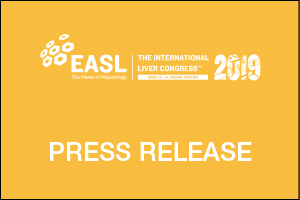
ILC 2019: Randomized controlled study reports favourable virological outcomes with simplified monitoring of glecaprevir/pibrentasvir treatment in chronic hepatitis C infection
13 April 2019, Vienna, Austria
EASL (EUROPEAN ASSOCIATION FOR THE STUDY OF THE LIVER)
A randomized controlled study (SMART-C) designed to determine whether treatment monitoring can be simplified in individuals with chronic hepatitis C infection receiving glecaprevir/pibrentasvir (GLE/PIB)1 has reported favourable efficacy and safety outcomes. The study reported today at The International Liver Congress™ 2019 in Vienna, Austria found similar virological and safety outcomes between individuals monitored using a standard protocol and those seen only at 12 weeks after the end of treatment. This, say the investigators, could enhance HCV treatment scale-up, helping to achieve global elimination targets.
Current standard on-treatment monitoring in clinical trials involves clinic-based visits every 4 weeks.1 However, in the modern era of direct-acting antivirals (DAAs), where treatments are easy to use, well tolerated, effective, and of a short duration, such intensive monitoring may no longer be necessary.1 The DAA, glecaprevir/pibrentasvir is a suitable candidate for simplified monitoring as it has pangenotypic activity with good efficacy and tolerability, and is dosed once daily for a short duration of treatment (8 or 12 weeks for most).1,2
The hypothesis being tested in the study reported today was that a simplified on-treatment monitoring strategy would be non-inferior to the standard on-treatment strategy.1 To test the hypothesis, treatment-naïve adults with chronic HCV infection without cirrhosis were randomized to receive treatment with GLE/PIB (300/120 mg) once-daily for 8 weeks and to be monitored using either a standard or simplified strategy. In the standard strategy group, participants attended study centre visits at baseline, weeks 4 and 8, and post-treatment week 12. With the simplified strategy, participants attended only at baseline and post-treatment week 12, with study nurse telephone contact made at weeks 4 and 8. Individuals thought to need extra adherence support, including those with recent injection drug use, were not eligible to participate. The primary endpoint was SVR at 12 weeks post-treatment (SVR12), with a non-inferiority margin for difference of 6%.
A total of 380 individuals were randomized (2:1) and treated with GLE/PIB in the simplified monitoring (n=253) and standard monitoring (n=127) arms. Overall, 60% of participants were male, 48% were genotype (GT) 1, 32% were GT3, 7% were HIV positive, and 10% were on opiate agonist therapy. In an intention-to-treat analysis, SVR12 was 92% (95% confidence interval [CI] 89%, 95%) in the simplified arm and 95% (95% CI 92%, 99%) in the standard arm. The difference between the arms was –3.2% (95% CI -8.2%, 1.8%), which was not statistically significant (p=0.25), but non-inferiority was not quite achieved as the lower bound of 95% CI (-8.2%) was greater than -6% margin. In the per-protocol population, SVR12 was 97% (95% CI 96%, 99%) in the simplified arm and 98% (95% CI, 96%, 100%) in the standard arm.
Only one participant (simplified monitoring group) discontinued due to an adverse event (AE); no treatment-emergent serious AEs were reported.
‘This study has indicated that a simplified monitoring strategy for ’easy-to-manage’ individuals initiated on GLE/PIB is feasible and associated with similar virological outcomes to those of individuals monitored more intensively,’ said Principal Investigator, Professor Gregory Dore, from the University of New South Wales in Sydney, Australia. ‘Simplified monitoring of new-generation DAAs such as GLE/PIB could enhance the rapid scale-up of treatment, which will help to achieve the WHO’s goal of eliminating chronic HCV infection as a major public health threat by 2030.3,4’
###
About The International Liver Congress™
This annual congress is the biggest event in the EASL calendar, attracting scientific and medical experts from around the world to learn about the latest in liver research. Attending specialists present, share, debate and conclude on the latest science and research in hepatology, working to enhance the treatment and management of liver disease in clinical practice. This year, the congress is expected to attract approximately 10,000 delegates from all corners of the globe. The International Liver Congress™ 2019 will take place from 10–14 April 2019 at the Reed Messe Wien Congress and Exhibition Center, Vienna, Austria.
About The European Association for the Study of the Liver (EASL)
Since its foundation in 1966, this not-for-profit organization has grown to over 4,000 members from all over the world, including many of the leading hepatologists in Europe and beyond. EASL is the leading liver association in Europe, having evolved into a major European association with international influence, and with an impressive track record in promoting research in liver disease, supporting wider education and promoting changes in European liver policy.
Contact
For more information, please contact the ILC Press Office at:
- Email: press2@easloffice.eu
- Telephone: +44 (0)1444 811099
Onsite location reference
Session title: ‘Hepatitis C – Treatment and resistance’
Time, date and location of session: 08:00–08:15, 13 April 2019, Main plenary
Presenter: Gregory Dore, Australia
| Abstract: Simplified monitoring for hepatitis C virus treatment with glecaprevir plus pibrentasvir: the SMART-C study (PS-178) |
Author disclosures
Gregory Dore has received research grants, travel support and fees for speakers bureau and advisory boards from AbbVie, Gilead Sciences, and Merck.
References
- S. National Library of Medicine. Trial of simplified treatment monitoring for 8 weeks glecaprevir/pibrentasvir in chronic hepatitis C patients (SMART-C). Available from: https://clinicaltrials.gov/ct2/show/NCT03117569. Last accessed: March 2019.
- Mensa FJ, et al. Glecaprevir/pibrentasvir for the treatment of chronic hepatitis C virus infection. Future Microbiol. 2019;14:89–110.
- World Health Organization. Global health sectors strategy on viral hepatitis 2016–2021: towards ending viral hepatitis (2016). Available from: https://www.who.int/hepatitis/strategy2016-2021/ghss-hep/en/. Last accessed: March 2019.
- Dore GJ, Feld Hepatitis C virus therapeutic development: in pursuit of “perfectovir”. Clin Infect Dis. 2015;60(12):1829–36.
